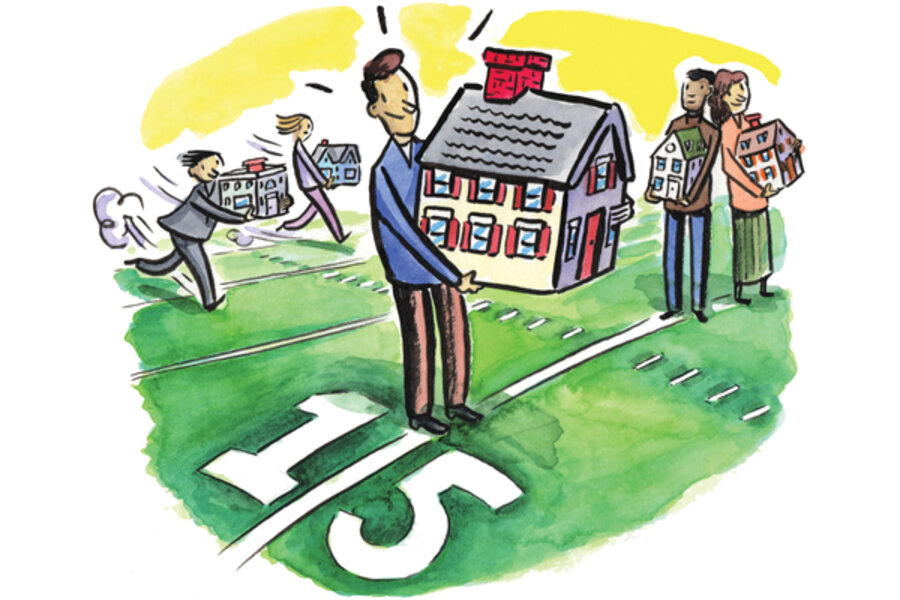Americans now love 15-year fixed mortgages
Loading...
Move over, 30-year fixed-rate mortgage. A shorter-term loan is enticing scores of home-owners to switch, now that they can finally afford to do so.
Record-low rates are helping transform the 15-year mortgage from a rarely used instrument into a popular option, especially for refinancers. In November, 23 percent of refinance applications were for 15-year loans, according to the Mortgage Bankers Association. That's up 51 percent from a year earlier.
The trend has gained steam since the economic slowdown led consumers to start slashing their debts. Fifteen-year mortgages made up just 8.5 percent of all refinance loans in 2007, but they made up 35 percent of the total last year, according to CoreLogic, a consumer research firm based in Irvine, Calif. One reason: Paying off the note in half the time means huge long-term savings in interest payments.
"Consumers are financially savvy, and they recognize 30-year fixed mortgages are a bargain," says Frank Nothaft, chief economist at Freddie Mac, a major provider of mortgage capital based in McLean, Va. "But then they say, 'Gosh, a 15-year fixed is three-quarters of a percentage point even lower'.... You can lock that in and never have to worry about refinancing again."
While 15-year loans have always been an interest-saving option, they usually come with a trade-off: higher monthly payments. That's because 15-year loans are structured to pay down principal more aggressively each month.
But today's extraordinary rates are changing the calculus. Interest on a 15-year loan hasn't been this low since at least the 1940s. Seldom have 15-year loans been so much cheaper than 30-year loans, according to Mr. Nothaft.
Until mid-December, Jeffrey and Amber DeGraaf of Kennewick, Wash., were paying 5.75 percent on a 30-year adjustable-rate mortgage that they took out in 2005 for $149,000. Their monthly payment was $1,097.
When they refinanced in December into a 15-year fixed at 3 percent, their monthly payment rose by only $123. The benefits far outweighed the $3,600 in refinance charges, Mr. DeGraaf says. The family expects to save around $70,000 in long-term interest. Plus they'll own their three-bedroom home free and clear eight years sooner.
"A lot of people would say, 'Another $120 a month? I don't know if I've got that'," says DeGraaf, a government contractor. "But to me, if you can afford it, it's worth it. You have your house paid off sooner. And you think about all the interest that you now won't be paying."
The DeGraafs have plenty of company, especially in regions where home prices aren't so high that a larger monthly payment would be out of the question. In five Midwestern states with relatively strong economies and low home prices, 30 to 40 percent of all refinanced loans are for 15-year terms.
The trend has followers on the coasts, too. Gesa Credit Union, based in Richland, Wash., which refinanced the DeGraafs, authorized 330 new 15-year refinance loans in 2012, up from 200 in 2010.
"In the second year of [a 15-year] loan, more than half of your payment is going towards principal," Randy Wacker, Gesa's vice president of mortgage lending, says via e-mail. "On a 30-year loan, that doesn't happen until year 11!"
The 15-year loan isn't for everyone. More than 80 percent of loans for new home purchases still utilize the 30-year fixed. For first-time buyers, the 30-year's low payments can be critical to home-ownership's success, Nothaft says.
Yet for those who can afford a higher payment, there's no reason to wait to refinance, he says. "We're not anticipating further substantial declines in mortgage rates from these very, very low levels. So since they're at pretty much the low right now, why delay?"
It doesn't help the economy in the short run to have consumers steering disposable income into larger monthly loan payments, according to Mike Fratantoni, vice president of research and economics for the Mortgage Bankers Association in Washington, D.C. But long term, "households have been saving more and accumulating less debt. That's going to build a more sustainable framework for [economic] growth going forward because people are living a little farther from the edge" of insolvency.







